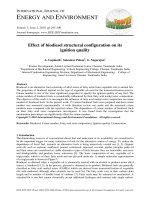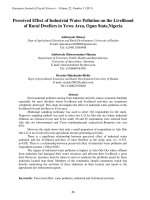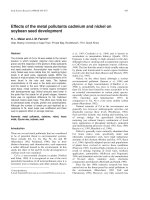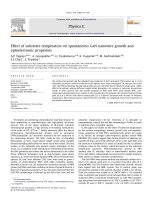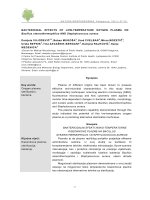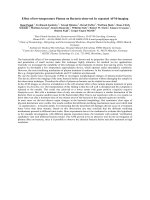Effect of low temperature plasma on bacteria observed by repeated AFM imaging
Bạn đang xem bản rút gọn của tài liệu. Xem và tải ngay bản đầy đủ của tài liệu tại đây (86.84 KB, 1 trang )
Effect of low-temperature Plasma on Bacteria observed by repeated AFM-imaging
René Pompl
1
, Ferdinand Jamitzky
1
, Tetsuji Shimizu
1
, Bernd Steffes
1
, Wolfram Bunk
1
, Hans-Ulrich
Schmidt
3
, Matthias Georgi
2
, Katrin Ramrath
2
, Wilhelm Stolz
2
, Robert W. Stark
4
, Takuya Urayama
5
,
Shuitsu Fujii
5
, Gregor Eugen Morfill
1
1
Max-Planck-Institute for Extraterrestrial Physics, D-85748 Garching, Germany.
Phone/FAX: +49-89-30000-3510/+49-89-30000-3950 E-mail:
2
Clinic of Dermatology, Allergology and Environmental Medicine, Hospital Munich Schwabing, 80804 Munich,
Germany.
3
Institute for Medical Microbiology, Hospital Munich Schwabing, 80804 Munich, Germany.
4
Center for Nanoscience, Ludwig-Maximilians-Universität, Theresienstr. 41, 80333 München, Germany.
5
ADTEC Plasma Technology Co. Ltd., 721-0942 Hiroshima, Japan.
The bactericidal effect of low-temperature plasmas is well known and its properties like contact-free treatment
and penetration of small cavities make this technique highly attractive for medical in-vivo applications.
Currently we investigate the suitability of this technique in the treatment of chronic foot and leg ulcers. For this
purpose we developed a low temperature argon-plasma device, which operates under atmospheric conditions.
However, the exact sterilising mechanism of plasma treatment is unknown. In the literature several explanations
like e.g. charged particles, generated radicals and UV radiation are discussed.
We use the atomic force microscope (AFM) to investigate morphological changes of plasma-treated bacteria.
This device allows the imaging of the same bacteria before and after treatment without damaging the sample by
the observation technique. Therefore the effect of plasma on bacteria can be studied in more detail.
In the AFM images we observe a breakdown in the cell structure after a three minute plasma treatment of gram
negative Escherichia coli. Our interpretation of this finding is that the cell wall is disrupted and the cytoplasm is
released to the outside. This result was achieved to a lower extent with gram positive coagulase negative
Staphylococcus. But with a treatment time of only one minute we did not observe a similar destruction of the
bacteria. Here we assume another cause for the bactericidal effect. Due to our experience with ex-vivo results we
know that even after a treatment time of one minute most of the bacteria in the exposed region are inviable.
In most cases we did not observe major changes in the bacterial morphology. But sometimes clear signs of
physical destruction were visible. Our results confirm that different sterilising mechanisms must exist which lead
- in superposition - to bacteria death. It is interesting that the described cell damages did not occur at a treatment
times lower than three minutes. Based on this observation one may conclude that the different sterilising
mechanisms proceed at different time scales. More experiments have to be conducted to evaluate this hypothesis
as for example investigations with different plasma exposition times, the treatment with isolated “sterilization
candidates” and with different bacteria strains. The AFM proved to be an attractive tool for the investigation of
plasma effect on bacteria, since it is possible to observe the identical bacteria before and after treatment at high
resolution.
